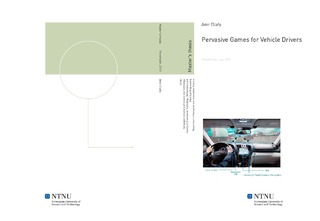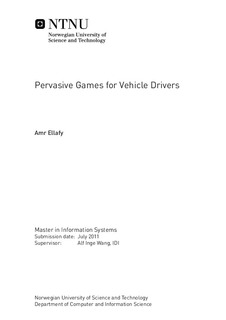| dc.contributor.advisor | Wang, Alf Inge | nb_NO |
| dc.contributor.author | Ellafy, Amr | nb_NO |
| dc.date.accessioned | 2014-12-19T13:37:20Z | |
| dc.date.available | 2014-12-19T13:37:20Z | |
| dc.date.created | 2011-09-13 | nb_NO |
| dc.date.issued | 2011 | nb_NO |
| dc.identifier | 440521 | nb_NO |
| dc.identifier | ntnudaim:6329 | nb_NO |
| dc.identifier.uri | http://hdl.handle.net/11250/252487 | |
| dc.description.abstract | Pervasive games are a new gender of games that is gaining popularity in recent years.The potential of pervasive games is their ability of mixing real-life physical objects in the gameplay, creating a thrilling experience for players.This thesis work researches the possibility of engaging vehicle drivers in pervasive games with road safety as the primary concern.First a research of main causes of traffic accidents is conducted though available statistics.The statistics shows that the human-factor contributes to the top five causes of traffic accidents.The statistics also concluded that the driver psychophysiological state is vital for road safety.Factors conditioning human's psycho physiological state are analyzed from computer games perspective.Affective Gaming, a gender of gaming highly dependent on player psychophysiological state, is further studied in terms of its applicability for in-vehicle use.The study includes researching various methods of capturing human psychophysiological state.Furthermore, different types of pervasive games are discussed including state of the art games available for vehicles.A research is conducted to cover available driver support systems and show how they work and contribute to road safety.Heads-up Display are also discussed as a method of displaying information to the driver with minimal distraction from driving.Relevant concepts and technologies in relation to pervasive games, driver support systems and road safety were defined and utilized as a basis for the conceptual framework which was developed in this thesis work. The framework shows how pervasive games can be used to contribute to road safety using various driver support systems. The idea is illustrated in a set of example game scenarios.A simulation software is used to demonstrate a part of the conceptual framework as a proof of concept.An important outcome of this thesis includes a conceptual framework for pervasive game implementation. The guidelines and relevant technologies are indispensable not only for pervasive games, but also for other multimedia (infotainment) application development and integration in the vehicle environment in terms of road safety and driving quality. | nb_NO |
| dc.language | eng | nb_NO |
| dc.publisher | Institutt for datateknikk og informasjonsvitenskap | nb_NO |
| dc.subject | ntnudaim:6329 | no_NO |
| dc.subject | MSINFOSYST Master in Information Systems | no_NO |
| dc.subject | Information Systems Engineering | no_NO |
| dc.title | Pervasive Games for Vehicle Drivers | nb_NO |
| dc.type | Master thesis | nb_NO |
| dc.source.pagenumber | 89 | nb_NO |
| dc.contributor.department | Norges teknisk-naturvitenskapelige universitet, Fakultet for informasjonsteknologi, matematikk og elektroteknikk, Institutt for datateknikk og informasjonsvitenskap | nb_NO |

